
EARLIEST ELECTRIC MOTORS and CARS
What might the earliest model vehicles have looked like?
There is a replica of one of the earliest at the University of Groningen museum
in the Netherlands. Again there are claims of earlier electric powered vehicles
but information on them is at best sketchy. Sibrandus Stratingh (1785-
Thomas Davenport (1802-
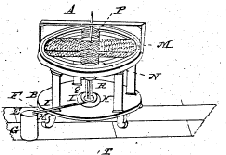
Davenport’s 1837 electric motor patent

The Oldest Slot Car and its 19th Century Predecessors
What was the first slot car? There are surviving electric powered model cars from 1912, but what about the earlier inventions that led up to it. We’ll start by looking at the earliest of electric motors, then the earliest electric powered “model size” vehicles before moving on to the earliest vehicles we might recognise as slot cars. This is a story about electric powered vehicles, maybe there is a story to tell about slot cars powered by clockwork, steam engines or whatever, but this isn’t it!
Where should the story start? Before an electric powered car can be built, somebody has to invent an electric motor. The principle of electric motors was first demonstrated in 1821 by Michael Faraday. Once the principle was established, various scientists/ inventors followed on by producing motors with rotating wound armatures and commutators to switch the current in the coils. There are conflicting claims about who made the first electric motor with a commutator, it’s entirely possible such a motor was invented independently several times. An early examples of electric motors with armature, commutator and stator were demonstrated in 1827/1828 by Hungarian scientist Ányos Jedlik and a motor capable of turning machinery was developed by British scientist William Sturgeon in 1832. These have most of the main feature of the motors used in almost all slot cars today.
Earliest electric powered “model size” vehicles
So when did a “car” powered by one of these early motors first appear? We are going back to a time when road vehicles were the normally horse drawn, the latest the latest high tech was steam powered railway locos and only a very few inventors had experimented with steam powered carriages on the roads. Inventions are often first demonstrated on a small scale before a full size one is built. It should be no surprise if the principle of electric powered cars was first proven with “model size” vehicles before the anything large enough to carry people was built. Putting the then newly invented electric motor in a wheeled vehicle is obvious enough to have been undependably invented many times, and it’s reasonable to expect the designs would owe something to horse drawn vehicles or railway locos.
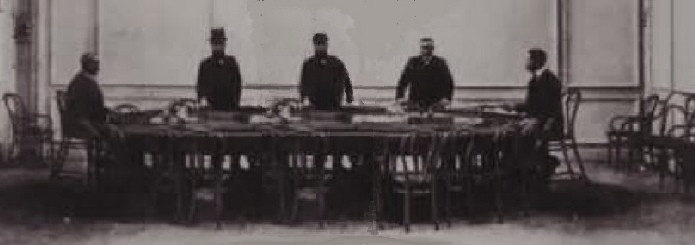
Earliest Raceway?
The earliest electric model car racing system is claimed to have been at Chateau
de la Source, (later called Chateau du Donjon ) in Le Pecq / St Germain, France.
The Chateau was run as a Spa between 1903 and 1914 and the model car racing was
introduced as an additional attraction sometime during this period . A postcard
of the model car track has been dated as 1906, but this dating is desputed.
A contemporary illustration showing the electric car racing system, at Chateau de la Source.
The cars were said to be electric, but no other detail of how the cars worked is given in the sources I've seen. No close up photos of the track have come to light. From magnifying the images of the photos that survive, the track appears to be oval or circular with at least 4 lanes. There appear to be either rails, barriers or slots defining the lanes. The cars could be rail guided, slot guided or guided by the barriers. It is possible the cars had their own electric motors, or perhaps they were pulled round by a string in the bottom of a slot (as in some arcade games in the period). They could have been free running battery powered cars. Around the turn of the century, model railway locomotives with electric motors became available from German and US manufacturers but the photos don’t seem to show model railway track . Märklin and Brianne produced some electric powered model cars in this period (see below) , these could be classified as rail rather than slot cars. Also there are examples of railway locomotive chassis running on model railway track with a model of a car body replacing the steam locomotive body.
So was this system slot racing? In the absence of further evidence it’s uncertain if they were guided by a slot or by some other means. 0f course it is always possible more evidence will come to light.
What was the Earliest Slot Car?
Below are some early electric powered model cars, I’ll leave it to the reader to decide where they draw the line between slot cars and other sorts of model car.
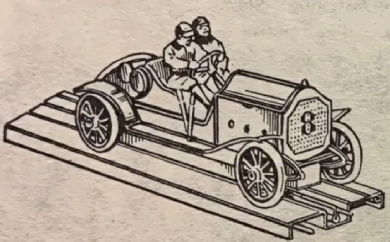

Copyright © 2021 updated 2023 British Slot Car Racing Association All rights reserved
This includes some monochrome illustrations no longer in copyright
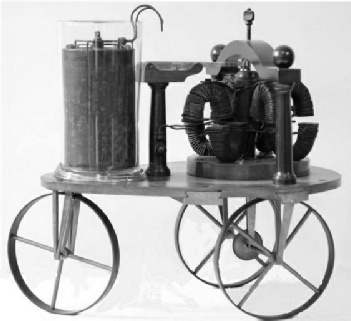
battery
motor
gear drive > to axle
Stratingh’s electric powered vehicle
In 1912 Lionel put electric racing car sets on the market, about 1200 were produced by 1916. A number of these sets survive.
Are these the oldest known slot cars in existence ? If you classify the Märklin and Brianne cars as rail cars, then YES if you accept these Lionel products as slot cars, but the track was somewhat different to modern slot cars . Here’s a more detailed description of the Lionel cars.
Märklin’s 1905 catalogue shows a different system where the car sits astride a 3 rail railway track. The car’s wheels sit on the ground either side of the railway track’s sleepers and the car has a guide on the central rail. Presumably the rails provide electrical connections. This certainly has similarities to later rail racing systems but isn’t much like a modern slot car syetem.
In 1908 French manufacturer Brianne made cars similar to Märklin’s 1905 cars, apparently the Brianne designs were based on the Märklin cars.
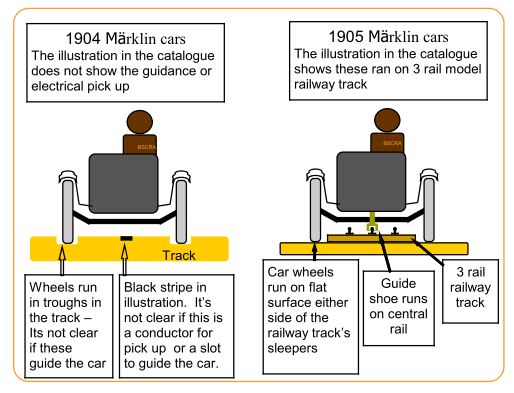
The 1904 catalogue from German manufacturer Märklin show some electric powered model cars running on a one lane track. A good look at a surviving example of the cars and track would tell us how it all worked. Unfortunately no surviving examples have been found (yet!), so all we have to go on is the artists illustration and a few words in the catalogue. What can be seen from the illustrations is that power is feed to the track and the car’s wheels seem to run in sunken troughs on either side. It seems the cars have electric motors and pick up power from the track, although exactly how they pick up isn’t shown. The illustration shows a black line in the centre of the track, we can speculate that must be something to do with electrical pick up or guidance or both. It’s not clear if the artist is showing a flat surface or a slot. Obviously the cars must be guided round the track by something, it could be a central slot, it could be the wheels running in the pair of sunken troughs or possibly the guidance system isn’t shown by the artist . Also there has to be two connections to the track for electricity to flow, so if the centre black stripe is one connection where is the other one?